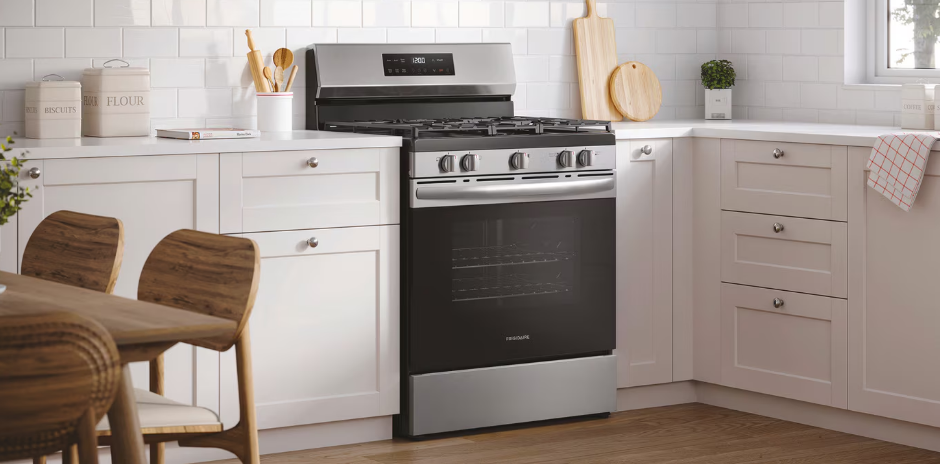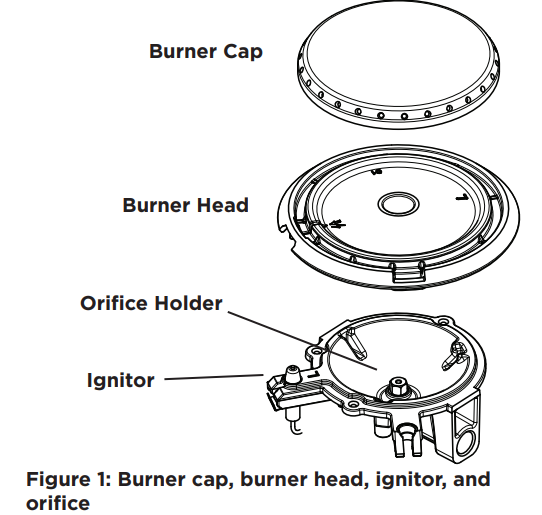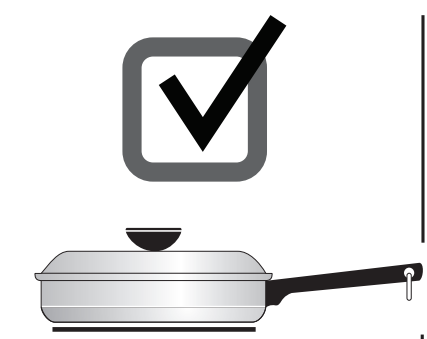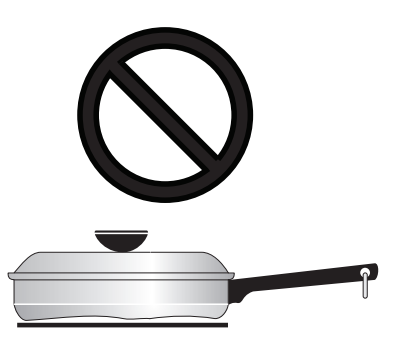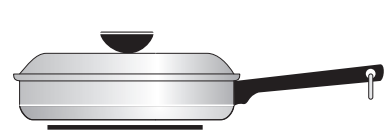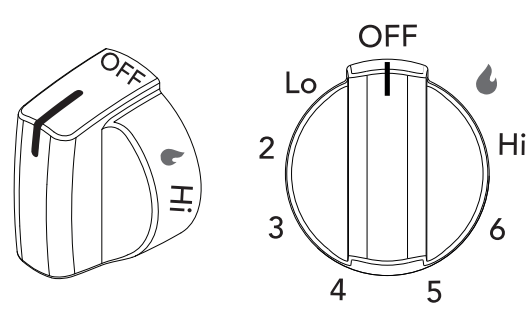
FRIGIDAIRE GCRG3060BD Gallery 30-inch Gas Range
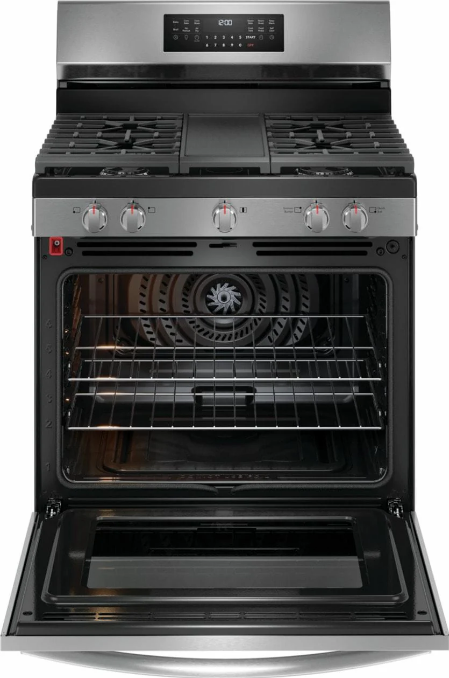
IMPORTANT SAFETY INSTRUCTIONS
- Read all instructions before using this appliance.
- This manual contains important safety symbols and instructions. Please pay attention to these symbols and follow all instructions given.
- Do not attempt to install or operate your appliance until you have read the safety precautions in this manual. Safety items throughout this manual are labeled with a WARNING or CAUTION statement based on the risk type.
- Warnings and important instructions appearing in this guide are not meant to cover all possible conditions and situations that may occur. Common sense, caution, and care must be exercised with installing, maintaining, or operating your appliance.
- Never allow children to play with packaging material. Do not remove the wiring label and other literature attached to the appliance. Do not remove the model/serial number plate.
- Cold temperatures can damage the electronic control. When using this appliance for the first time, or when the appliance has not been used for an extended period of time, be sure the appliance has been in temperatures above 32ºF (0ºC) for at least 3 hours before turning on the power to the appliance.
- All materials used in the construction of cabinets, enclosures, and supports surrounding the product must have a temperature rating above 200°F (94°C).
- Never modify or alter the construction of the appliance by removing the leveling legs, panels, wire covers, anti-tip brackets/screws, or any other part of the appliance.
- Be sure to have an appropriate foam-type fire extinguisher available, visible, and easily accessible, located near the appliance.
BEFORE SETTING SURFACE CONTROLS
Gas surface burner types
The cooktop is equipped with gas surface burners with different BTU ratings. The ability to heat food quickly and in large amounts increases as the burner size increases.
- Small burners are best used for low-flame heating of small amounts of food.
- Standard burners can be used for most surface cooking needs.
- The largest burner is best used for bringing large quantities of liquid rapidly up to temperature or when preparing larger quantities of food. The large burner is located at the right front position on the cooktop.
- Regardless of size, always select cookware that is suitable for the amount and type of food being prepared. Select a burner and set the flame size appropriately for the pan. Never allow flames to extend beyond the outer edge of the pan.

Assembly of the Burner Caps
Make sure that all of the surface burner caps and surface burner grates are installed correctly and at the correct locations.
- Remove all packing material from the cooktop area.
- Make sure the burner head and caps are properly placed on the surface burners.
Important: The burner head has a hole that fits over the ignitor. Make sure the head fits snugly before placing the burner caps. Note: Unpack the burner grates and position them on the cooktop after the burner heads and caps are properly installed.
Using Proper Cookware
The size and type of cookware used will influence the heat setting needed for the best cooking results. Be sure to follow the recommendations for using proper cookware as illustrated in “Figure 2: Testing cookware” and “Figure 3: Proper cookware”. Check for flatness by rotating a ruler across the bottom of the cookware (see “Figure 2: Testing cookware”). Cookware should have flat bottoms that make good contact with the entire surface of the heating element.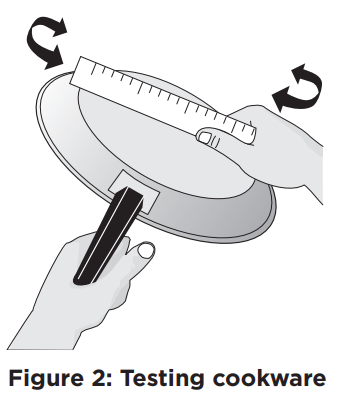
- Flat bottom and straight sides.

- Tight-fitting lids.
- The weight of the handle does not tilt the pan. Pan is well-balanced.
- Pan sizes match the amount of food to be prepared and the size of the surface element.
- Made of a material that conducts heat well.
- Easy to clean.
- Always match pot diameter to element size.
- Curved and warped pans.

- Cookware larger than the element by more than one-half inch or 12mm.

- Heavy handle tilts the pan.

- Pan is much smaller than the element.

Cookware Material Types
The cookware material determines how evenly and quickly heat is transferred from the surface element to the pan bottom. The most popular materials available are:
- Aluminum – Excellent heat conductor. Some types of food will cause it to darken (Anodized aluminum cookware resists staining and pitting).
- Copper – Excellent heat conductor but discolors easily (see Aluminum).
- Stainless – Slow heat conductor with uneven cooking results. Durable, easy to clean, and resists staining.
- Cast Iron – A slow heat conductor, but it will retain heat very well. Cooks evenly once the cooking temperature is reached.
- Porcelain-enamel on metal – Heating characteristics will vary depending on base material.
- Glass – Slow heat conductor.
Install Burner Grates
To install burner grates, place the grates flat-side down and align them into the cooktop recess.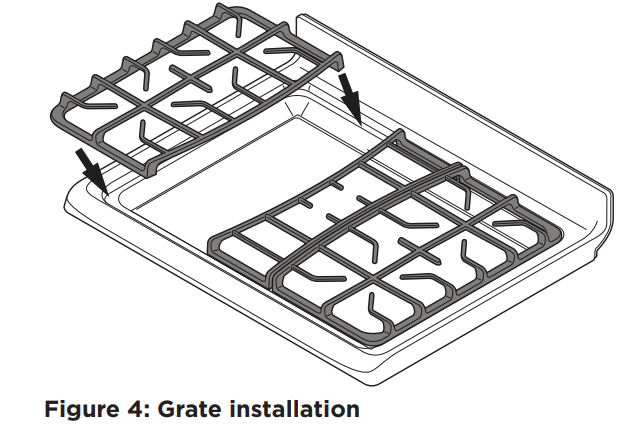
Home Canning
Be sure to read and observe all the following points when home canning with your appliance. Check with the USDA (United States Department of Agriculture) website and be sure to read all the information they have available as well as follow their recommendations for home canning procedures.
- Use only a completely flat-bottom canner with no ridges that radiate from the bottom center when home canning. Heat is spread more evenly when the bottom surface is flat. Use a straight-edge to check the canner bottom.
- Make sure the diameter of the canner does not exceed 1 inch (25mm) beyond the surface element markings or burner.
- It is recommended to use smaller diameter canners on electric coil and ceramic glass cooktops and to center canners on the burner grates.
- Start with hot tap water to bring the water to a boil more quickly.
- Use the highest heat setting when first bringing the water to a boil. Once boiling is achieved, reduce the heat to the lowest possible setting to maintain that boil.
- Use tested recipes and follow instructions carefully. Check with your local Cooperative Agricultural Extension Service or a manufacturer of glass jars for the latest canning information.
- It is best to carry small amounts and light loads. Do not leave water bath or pressure canners on high heat for an extended period of time.
Setting a surface burner:
- Place the cooking utensil in the center of the surface burner grate. Be sure the cooking utensil rests stably on the burner grate.
- Push the burner’s surface control knob in and turn counterclockwise out of the OFF position (Figure 1).
- Release the surface control knob and rotate to the LITE
 position. Visually check that the burner has a steady gas flame.
position. Visually check that the burner has a steady gas flame. - Once the surface burner has a flame, push the surface control knob in and turn counterclockwise to the desired flame size setting. Adjust the flame as needed using the knob markings.

Set proper burner flame size
The color of the flame is the key to proper burner adjustment. A good flame is clear, blue, and hardly visible in a well-lighted room. Each cone of flame should be steady and sharp. Adjust or clean the burner if the flame is yellow-orange.
For most cooking:
Start on the highest setting and then turn to a lower setting to complete the process. Use the recommendations below as a guide for determining proper flame size for various types of cooking (Table 1).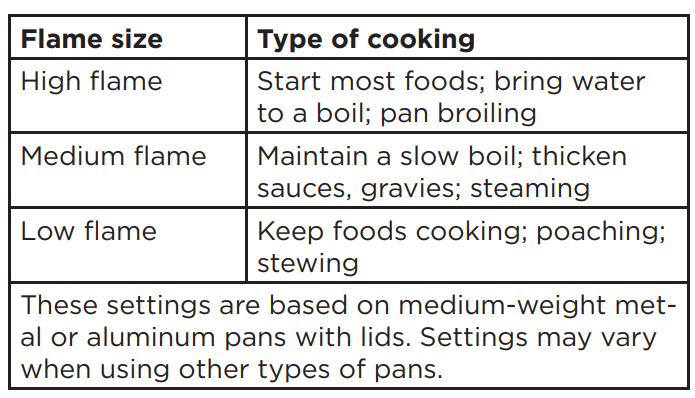
For deep fat frying:
Use a thermometer and adjust the surface knob accordingly. If the fat is too cool, the food will absorb the fat and be greasy. If the fat is too hot, the food will brown so quickly that the center will be under-cooked. Do not attempt to deep-fry too much food at once, as the food will neither brown nor cook properly
SETTING OVEN CONTROLS

- Bake is for delicate foods that need heat to rise and move gently in the oven.
- Conv Bake circulates the oven heat continuously for baking.
- Conv Roast combines a cook cycle with the convection fan and elements to rapidly roast meats and poultry.
- Steam Bake creates the best conditions for baking bread on a single rack.
- Steam Roast creates the best conditions for roasting proteins.
- Keep Warm is used to keep cooked foods at serving temperature in the oven.
- Broil is for broiling and grilling foods under direct, high heat.
- No Preheat is for single-rack baking with packaged and convenience foods.
- Air Fry is for preparing packaged and convenience foods with little or no oil.
- Cook Time sets the oven to run for a period of time and then turn off.
- Food Probe sounds an alert when the internal temperature of food reaches the desired temperature.
- Self-Clean starts a self-cleaning cycle.
- Settings are used to set user preferences for various control functions, including:
- Hour: change between 12 and 24-hour mode.
- Audio: set the volume of the control keys or operate in silent mode.
- F-C: display temperatures in Fahrenheit or Celsius.
- Reset: reset all user preferences to original factory settings.
- UPO: adjust the oven temperature settings.
- E-S: change between 12-hour energy savings mode and continuous mode.
- Oven Light turns the interior light on and off at a touch and turns on automatically when the oven door is open.
- Timer On-Off is used to set or cancel the minute timer.
- Number Keys are for setting temperatures and times.
- START starts cooking functions and sets the clock.
- OFF turns off all cooking functions.
- Lockout deactivates the control panel to prevent accidental key presses and locks the oven door.
- Set Clock sets the time of day.
CARE AND CLEANING
Cleaning the surface burners
To avoid possible burns, do not attempt cleaning before turning off all surface burners and allowing them to cool. Any additions, changes, or conversions required in order for this appliance to satisfactorily meet the application needs must be made by an authorized qualified Agency. Routinely clean the cooktop. Wipe with a clean, damp cloth and wipe dry to avoid scratches. Keeping the surface burner head ports and slots clean will prevent improper ignition and an uneven flame. To clean recessed and contoured areas of the cooktop:
- If a spill occurs on or in the recessed or contoured areas, blot up the spill with an absorbent cloth.
- Rinse with a clean, damp cloth and wipe dry.
To clean burner heads:
- Remove the burner cap and the burner head. Clean with hot soapy water and dry thoroughly.
- For burned-on and dried spills, apply hot soapy water to the burner head. Allow time for the soils to soften.
- Use a toothbrush to clean all over the burner head.
- Use a needle or fine wire to clean out the ignition port.
- Wipe the burner head clean with a soft, clean cloth, sponge, or scratch-free cleaning pad.
- Before using the cooktop again, make sure the burner head has fully seated back into place and the burner cap is properly seated on the burner head. You can wiggle the cap to test placement; neither the cap nor the head should slide out of position.
General Cleaning
Refer to the table at the beginning of this chapter for more information about cleaning specific parts of the oven.
Follow these cleaning precautions:
- Allow the oven to cool before cleaning.
- Wear rubber gloves when cleaning the appliance manually.
- Remove soils using hot, soapy water. Do not allow food spills with a high sugar or acid content (such as milk, tomatoes, sauerkraut, fruit juices, or pie filling) to remain on the surface, as they may cause a dull spot even after cleaning. Remove spillovers and heavy soiling as soon as possible. Regular cleaning will reduce the effort required for major cleaning later.
BEFORE YOU CALL
Oven Baking
For best cooking results, preheat the oven before baking cookies, breads, cakes, pies, pastries, etc. There is no need to preheat the oven for roasting meat or baking casseroles. The cooking times and temperatures needed to bake a product may vary slightly from your previously owned appliance.
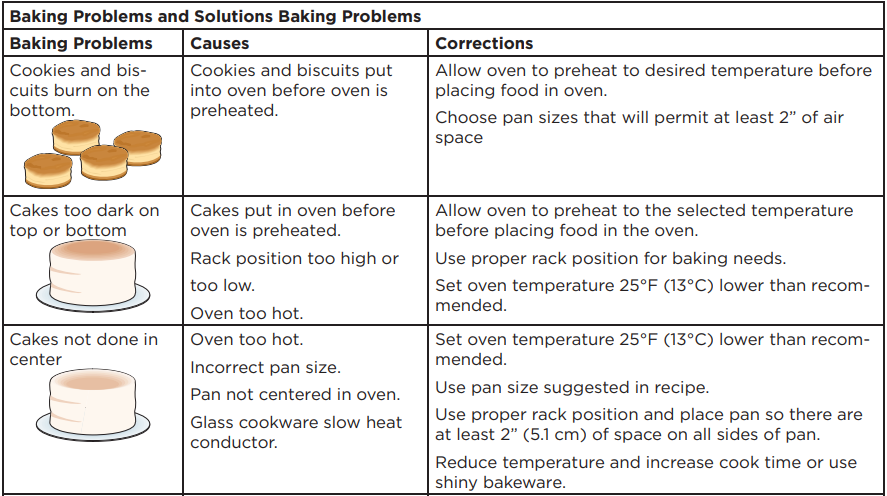
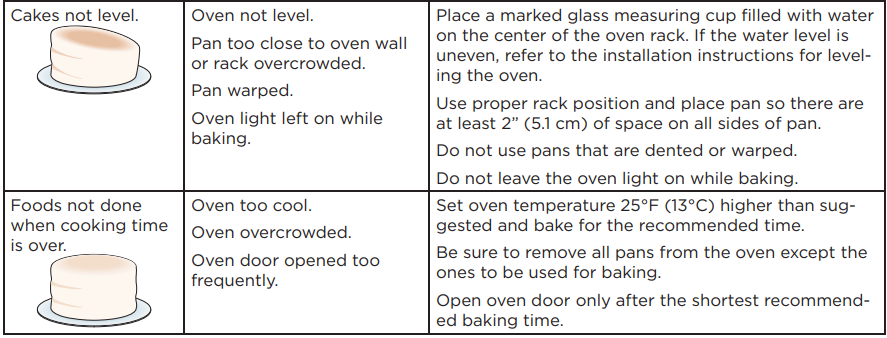
Let us help you troubleshoot your concern! This section will help you with common issues. If you need us, visit our website, chat with an agent, or call us. We may be able to help you avoid a service visit. If you do need service, we can get that started for you: 1-800-374-4432 (United States) Frigidaire.com
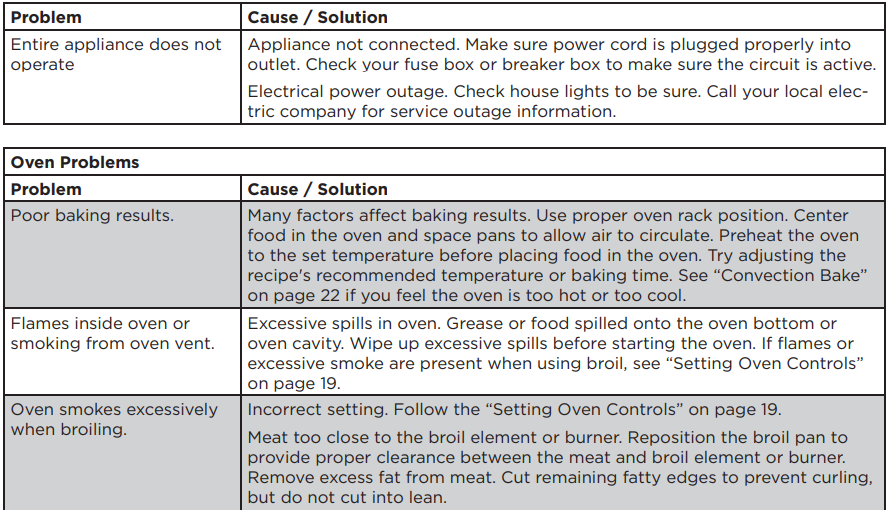
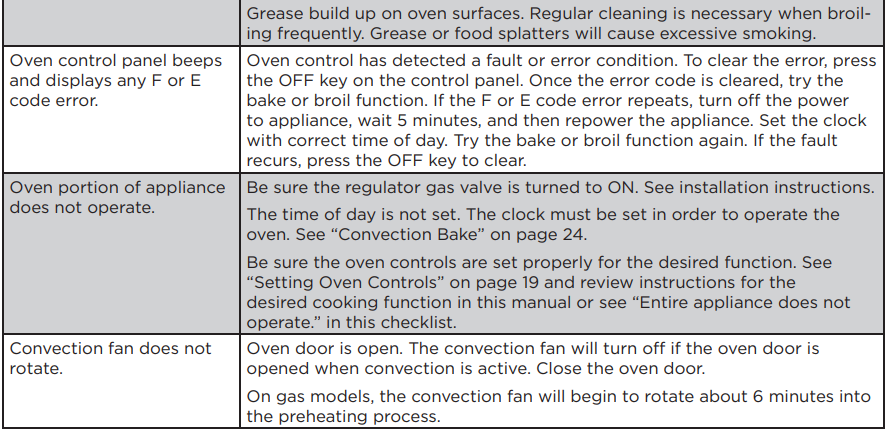
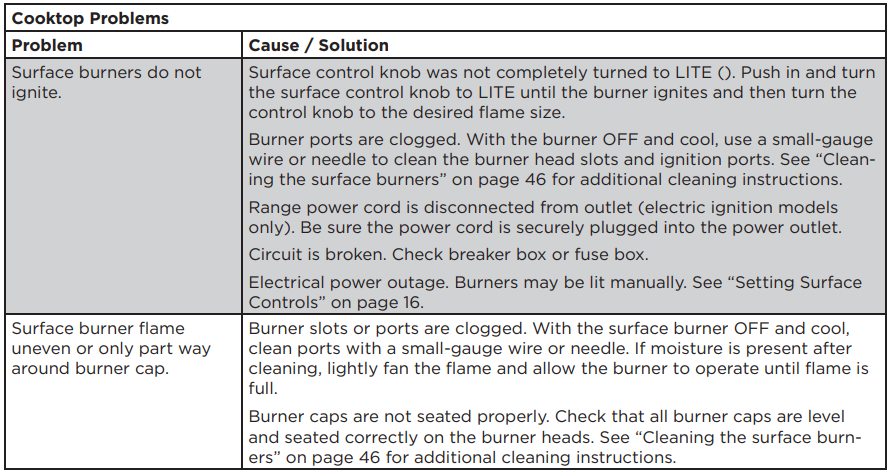

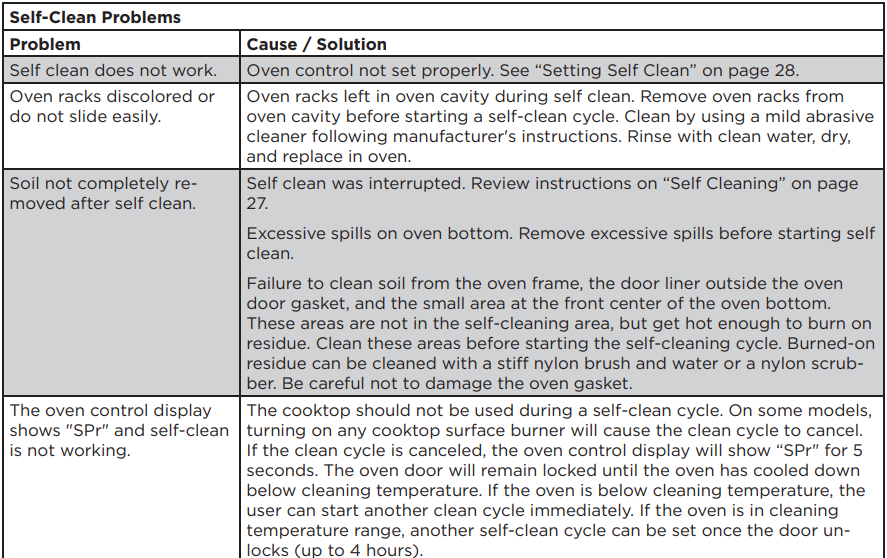
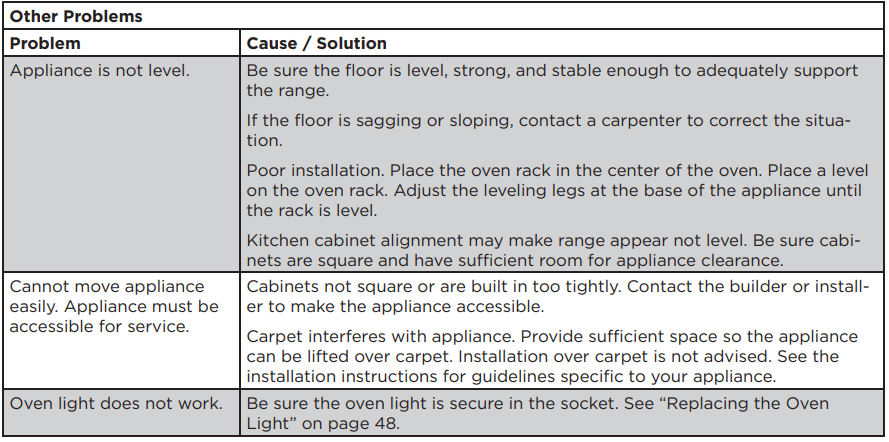
WARRANTY
Your appliance is covered by a one-year limited warranty. For one year from your original date of purchase, Electrolux will pay all costs for repairing or replacing any parts of this appliance that prove to be defective in materials or workmanship when such appliance is installed, used, and maintained in accordance with the provided instructions.
Exclusions
This warranty does not cover the following:
- Products with original serial numbers that have been removed, altered, or cannot be readily determined.
- A product that has been transferred from its original owner to another party or removed outside the USA or Canada.
- Rust on the interior or exterior of the unit.
- Products purchased “as-is” are not covered by this warranty.
- Food loss due to any refrigerator or freezer failures.
- Products used in a commercial setting.
- Service calls which do not involve malfunction or defects in materials or workmanship, or for appliances not in ordinary household use or used other than in accordance with the provided instructions.
- Service calls to correct the installation of your appliance or to instruct you on how to use your appliance.
- Expenses for making the appliance accessible for servicing, such as removal of trim, cupboards, shelves, etc., which are not a part of the appliance when it is shipped from the factory.
- Service calls to repair or replace appliance light bulbs, air filters, water filters, other consumables, or knobs, handles, or other cosmetic parts.
- Surcharges, including, but not limited to, any after-hour, weekend, or holiday service calls, tolls, ferry trip charges, or mileage expense for service calls to remote areas, including the state of Alaska.
- Damages to the finish of the appliance or home incurred during installation, including but not limited to floors, cabinets, walls, etc.
- Damages caused by: services performed by unauthorized service companies; use of parts other than genuine Electrolux parts or parts obtained from persons other than authorized service companies; or external causes such as abuse, misuse, inadequate power supply, accidents, fires, or acts of God.
DISCLAIMER OF IMPLIED WARRANTIES; LIMITATION OF REMEDIES
CUSTOMER’S SOLE AND EXCLUSIVE REMEDY UNDER THIS LIMITED WARRANTY SHALL BE PRODUCT REPAIR OR REPLACEMENT AS PROVIDED HEREIN. CLAIMS BASED ON IMPLIED WARRANTIES, INCLUDING WARRANTIES OF MERCHANTABILITY OR FITNESS FOR A PARTICULAR PURPOSE, ARE LIMITED TO ONE YEAR OR THE SHORTEST PERIOD ALLOWED BY LAW, BUT NOT LESS THAN ONE YEAR. ELECTROLUX SHALL NOT BE LIABLE FOR CONSEQUENTIAL OR INCIDENTAL DAMAGES, SUCH AS PROPERTY DAMAGE AND INCIDENTAL EXPENSES, RESULTING FROM ANY BREACH OF THIS WRITTEN LIMITED WARRANTY OR ANY IMPLIED WARRANTY. SOME STATES AND PROVINCES DO NOT ALLOW THE EXCLUSION OR LIMITATION OF INCIDENTAL OR CONSEQUENTIAL DAMAGES, OR LIMITATIONS ON THE DURATION OF IMPLIED WARRANTIES, SO THESE LIMITATIONS OR EXCLUSIONS MAY NOT APPLY TO YOU. THIS WRITTEN WARRANTY GIVES YOU SPECIFIC LEGAL RIGHTS. YOU MAY ALSO HAVE OTHER RIGHTS THAT VARY FROM STATE TO STATE.
If You Need Service
Keep your receipt, delivery slip, or some other appropriate payment record to establish the warranty period should service be required. If service is performed, it is in your best interest to obtain and keep all receipts. Service under this warranty must be obtained by contacting Electrolux at the addresses or phone numbers below. This warranty only applies in the USA and Canada. In the USA, your appliance is warranted by Electrolux Major Appliances North America, a division of Electrolux Home Products, Inc. In Canada, your appliance is warranted by Electrolux Canada Corp. Electrolux authorizes no person to change or add to any obligations under this warranty. Obligations for service and parts under this warranty must be performed by Electrolux or an authorized service company. Product features or specifications as described or illustrated are subject to change without notice.
For More Manuals By Frigidaire, Visit ManualsLibraryy.
FRIGIDAIRE GCRG3060BD Gallery 30-inch Gas Range-FAQs
Q1. Why is my Frigidaire Gallery gas range not heating?
The most common causes are a faulty igniter, a malfunctioning control board, or a broken bake element. If the burners work but the oven does not, the igniter is usually the issue.
Q2. How do I set the temperature on a Frigidaire Gallery oven?
Press the Temp button, turn the Temp/Timer knob to select your desired temperature, and press Set. Then, use the Time button to adjust baking time, and press Start/Cancel to begin.
Q3. How do I reset my Frigidaire gas range?
Unplug the range or turn off its circuit breaker for a few minutes, then restore power. This hard reset often clears minor control board errors.
Q4. How do I preheat the Frigidaire Gallery oven?
Turn the oven on, select your cooking mode and temperature, then press Start. Allow about 15–20 minutes for preheating to 350–400°F.
Q5. How do I know when my oven has finished preheating?
Most Frigidaire ovens have a preheat indicator light that turns off when the set temperature is reached.
Q6. Where is the temperature control on the Frigidaire Gallery oven?
The temperature is controlled from the electronic display panel using the Temp/Timer knob and control buttons.
Q7. Why does my gas oven take so long to heat up?
A slow-heating oven may have a faulty thermostat, weak igniter, or temperature sensor issues. Cleaning or replacing these parts usually resolves the problem.
Q8. What can cause my oven to overheat?
Overheating is often caused by a defective thermostat, cooling fan, or heating element not functioning properly.
Q9. What are the cooking modes in the Frigidaire Gallery oven?
The Total Convection System offers modes like Air Fry, No Preheat, Convection Bake, Convection Roast, Slow Cook, Steam Bake, Steam Roast, and Air Sous Vide.
Q10. Which oven mode is best for baking?
Convection (fan-forced) mode is best for baking, as it circulates hot air evenly for consistent results.

